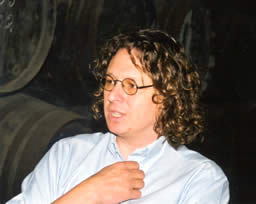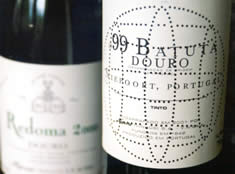
|
Another
dinner with Dirk
Niepoort
I’ve
met him now on a few occasions, so it was nice to be able to catch up
with him on a visit to London. It was a dinner at Richard Corrigan’s
Lindsay House restaurant (boasting a Michelin star) and while there
were plenty of well-known wine journalists present, as luck conspired
I managed to sit next to Dirk for a good portion of the evening. We
began with the 2001 Redoma Rosé. A deep pink wine, this is
quite serious for rosé, with plenty of structure, good acid and a
spicy edge. ‘A lot of people think they don’t like Rosé’, says
Dirk, ‘but this is because most Rosés are treated as garbage’.
Many are made with a bit of residual sugar to hide the mistakes. Dirk
first tried to do Rosé in 1996, and in 1999 he decided to step up the
quantity a bit. Initially it was made with saignée (vat bleeding) of
the best reds, but the result proved a little heavy. In
2000 Dirk changed things round a bit. Into the blend went some Tinta
Amarela that he’d picked early
to get good acidity and lower alcohol, and a portion of the
whole blend was barrel fermented. The results have been impressive.
Let’s face it, it has to be a good wine to retail as a Portuguese
Rosé for £8.99, a sector that people might have suspected dead after
the likes of Mateus and Lancers. I
like the rosé, but much prefer the second wine we tasted, the 2001
Redoma Branco. Dirk’s reds often steal the show, but his whites
are fully serious wines – I can’t think of many contenders for
Portugal’s best white than the Redoma Branco and it’s big brother,
the Reserva. No Reserva was made in 2001, so the regular Branco is the
top wine this year, and it’s delicious. ‘In
the beginning I didn’t believe that the Douro had good terroir for
white wines’, recalled Dirk. ‘But eventually we found a 70 year
old vineyard 400 metres high up where the grower was prepared to pick
the three white varieties separately’. The altitude is important in
the Douro for whites: at 400 m it is considerably cooler than the hot
temperatures at river level. All whites are made from vineyards with
400–600 m elevation. Dirk has decided that he doesn’t like
Malvasia Fina for table wines, and that Rabigato is one of his
favourites – this forms the base of his whites.
On
to the reds, which I’ve covered in quite a bit of detail elsewhere
on this site, so to avoid repeating myself I’d recommend you to look
at this page if you haven’t already. New this year is Vertente.
It’s positioned below the other reds, fashioned mainly from young
vineyards and bought-in grapes. It’s sees a shorter time in wood and
only 20% is aged in new barrels. There’s less Tinta Amarela and a
bit more Touriga Franca and Tinta Roriz. Dirk wanted to make a wine
with Douro character but which is approachable a bit earlier, and is
fruitier and cheaper than the others. The result is the 2000
Vertente, which is deep coloured with lots of ripe berry fruit,
good acidity an nice minerality. Quite structured and tasty, although
at £14 it’s not cheap. The
next red was the 2001 Redoma, a barrel sample, showing lots of
structure with some wildness to the herby, intense fruit. It’s
tannic, but shows lots of finesse: good concentration and minerality.
This retails at £25 or thereabouts, which is quite expensive but
worth the money. For this price you can get rather basic claret, but
here you are getting one of Portugal’s top 10 wines. But there’s
more. The 2000 Batuta is what Robert Parker would no doubt
describe as a ‘tour de force’. Very concentrated and tannic, this
is firm with intense bold fruit. Well balanced but just a baby at the
moment that needs time to show its best (retail £45 if you can find
it). Charme 2002 is a fascinating wine. It’s made from low
yielding vines picked a little early, with 100% stem contact. ‘I
want it to be light, concentrated and long’, says Dirk. This shows
ripe chocolatey edged fruity on the nose – ripe and full. Black
fruits dominate with tarry richness and some new oak. There’s great
elegance and finesse, with a rich spicy finish. Interesting stuff.
Charme has so far only been made in tiny quantities and is hard to
find, but retails for about the same as Batuta. We
moved on to Ports. The 1963 Colheita is a treat, with a lovely
intense, spicy cedary nose and raisiny, spicy complexity on the
palate. Niepoort Vintage Port 1970 is also an exceptional wine
showing exquisite balance: rich and full with good acid and nice
complexity. It still tastes a bit young. With all these wines it was
quite nice to be drinking rather than spitting. After all, this is
what wines is for, isn’t it? See
also: The Douro revolution; tasting
notes of Portuguese wines |

 The
Redoma Branco Reserva is usually made from three vineyards with a vine
age of greater than 100 years. One of these vineyards has granitic
soils. ‘I feel it is important: it shows the minerality of the
Schist in the blend a lot more’, says Dirk. The whites are fermented
and aged in barrels for 12 months with no racking. Yields in these old
vineyards range from 5–25 hl/ha, which are very low. Malolactic is
avoided to preserve the all important acidity.
The
Redoma Branco Reserva is usually made from three vineyards with a vine
age of greater than 100 years. One of these vineyards has granitic
soils. ‘I feel it is important: it shows the minerality of the
Schist in the blend a lot more’, says Dirk. The whites are fermented
and aged in barrels for 12 months with no racking. Yields in these old
vineyards range from 5–25 hl/ha, which are very low. Malolactic is
avoided to preserve the all important acidity.